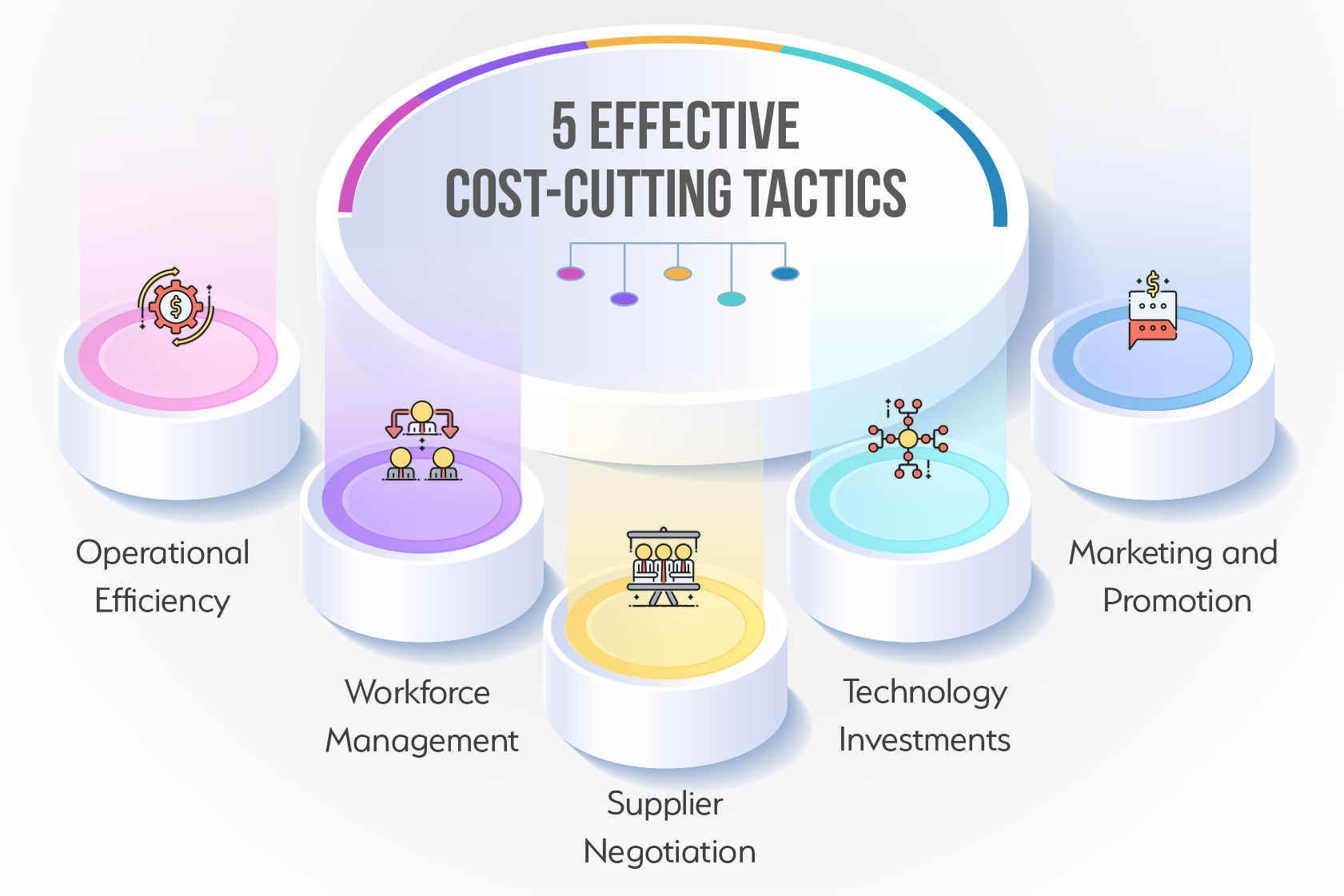Table of Content
Share This Article
- Published: February 19, 2024
- Last Updated: February 19, 2025
In the business world, economic downturns or recessions can pose significant challenges that test the resilience of even the most established enterprises. A recession is characterised by a decline in economic activity, often leading to minimised consumer spending, decreased revenue, and increased financial uncertainty. It becomes paramount for businesses to not only weather the storm but emerge stronger on the other side. The impact of a recession on businesses is profound, affecting everything from revenue streams to operational stability. In such turbulent times, the importance of proactive cost-cutting measures cannot be overstated. While it is natural to tighten the financial belt during tough economic periods, the key lies in making strategic, well-informed decisions that reduce costs and position the business for sustainable growth.
In this blog, we will explore the critical importance of proactive cost-cutting measures as a means to fortify your business during a recession. By delving into 5 effective cost-cutting tactics, we aim to provide practical insights that empower businesses to not only survive but thrive in the face of economic adversity. These business recession strategies encompass various aspects of business operations, allowing for a holistic approach to cost reduction while maintaining essential functions and preserving long-term viability. In the following post, we will navigate through these strategies, providing actionable guidance for businesses to navigate the challenges posed by a recession and emerge as more robust, adaptable, and forward-looking entities.
Assess Current Financial Health
Before embarking on the journey of implementing effective cost-cutting measures to recession-proof your business during a downturn, it is imperative for businesses to first assess their current financial health comprehensively. This step holds tremendous significance as it serves as the foundation upon which sound financial decisions can be made. Conducting a comprehensive financial assessment entails a meticulous examination of various facets of a company’s financial landscape.
First and foremost, cash flow analysis takes centre stage during this evaluation. It provides insights into the liquidity and sustainability of a business, offering a window into how efficiently cash moves in and out of the organisation. Understanding cash flow patterns is vital for ensuring that a business has the necessary resources to cover its day-to-day operations, repay debts, and seize opportunities for growth.
Additionally, revenue assessment forms a critical component of this financial health check. Businesses must scrutinise their income sources, stability, and dependence on specific clients or markets. By gaining a comprehensive understanding of revenue streams, companies can identify key areas of potential growth and assess the impact of economic fluctuations on their top line.
Equally crucial is the analysis of expenses. This involves a detailed examination of all costs incurred in running the business, including fixed and variable expenses. Pinpointing unnecessary or redundant costs, renegotiating contracts with suppliers, and optimising operational processes are among the strategies that can emerge from this assessment.
By conducting this financial health check, businesses can clearly understand their fiscal strengths and weaknesses. This understanding, in turn, empowers them to formulate tailored cost-cutting strategies that align with their unique financial circumstances and objectives. Armed with this knowledge, businesses can make informed decisions that enhance their short-term financial stability and position them for long-term success in a dynamic and often unpredictable economic landscape, utilising business recession strategies to their advantage.
Effective Cost-Cutting Tactics
Operational Efficiency:
Operational efficiency is a fundamental concept in business that focuses on optimising internal processes to achieve more with fewer resources. It involves streamlining workflows, eliminating redundancies, and adopting technology solutions to enhance productivity and reduce operational costs. Operational efficiency not only contributes to cost savings but also improves overall competitiveness and agility in a dynamic business landscape. It plays a pivotal role in helping organisations navigate challenges, such as making your business recession-proof, by ensuring that resources are used efficiently to maintain profitability and sustainability.
Workforce Management:
Workforce management is a crucial aspect of business operations that revolves around optimising the utilisation of human resources. This includes exploring strategies for workforce optimisation, such as implementing remote work options and embracing flexible staffing arrangements. Remote work not only enhances employee work-life balance but also lowers overhead costs associated with physical office spaces. Flexible staffing allows businesses to adapt to fluctuating workloads efficiently. Amid these strategies, effective employee communication and support are paramount. Clear and open communication channels foster employee engagement, ensuring that everyone is aligned with the organisation’s goals and objectives. Moreover, providing support, whether through training, mentorship, or mental health resources, contributes to employee well-being and productivity. Workforce management, when executed thoughtfully, enables businesses to leverage their most valuable asset—their workforce—and navigate economic challenges with resilience and adaptability.
Supplier Negotiation:
Supplier negotiation plays a pivotal role in effective cost-cutting strategies to recession-proof your business. Renegotiating contracts with suppliers offer multiple benefits, including cost reduction, improved terms, and enhanced value for the products or services procured. Successful supplier negotiations require a strategic approach. It involves conducting thorough research on market rates, understanding the supplier’s perspective, and identifying areas where mutual concessions can be made. Building strong supplier relationships which is based on trust and collaboration is key to fruitful negotiations. Furthermore, clear and transparent communication, the ability to leverage long-term partnerships, and the willingness to explore win-win solutions can significantly contribute to successful supplier negotiations. By effectively renegotiating contracts, businesses can achieve cost savings and strengthen their financial position, ultimately enhancing their competitive edge in challenging economic times.
Technology Investments:
Technology investments hold the potential to be transformative in cost-cutting efforts and productivity enhancement for businesses. Embracing technology can significantly reduce operational costs by automating manual processes and streamlining workflows. For instance, adopting cloud-based accounting software can simplify financial management, while inventory management systems can optimise stock levels and reduce wastage. Moreover, customer relationship management (CRM) software enhances customer interactions and sales tracking, leading to improved revenue. Implementing cost-effective technology solutions not only reduces costs but also enhances overall efficiency and competitiveness. In today’s digital age, leveraging technology is a strategic imperative for businesses aiming to thrive while maintaining financial sustainability as a part of their business strategies during recession.
Marketing and Promotion:
Maintaining an effective marketing presence while reducing expenses is a critical challenge for businesses during a recession. To navigate this, companies can explore creative marketing strategies that maximise impact without breaking the bank, a key aspect of business recession strategies. Leveraging digital platforms and social media allows for cost-effective online advertising, reaching a wide audience at a fraction of traditional marketing costs. Content marketing, including blog posts and informative videos, can establish thought leadership and engage customers without substantial expenditures. Collaborations and partnerships with complementary businesses can expand reach and share marketing costs. Additionally, focusing on customer retention and loyalty programs can be more cost-efficient than acquiring new customers. In challenging economic times, innovative and budget-conscious marketing approaches enable businesses to maintain visibility and customer engagement while prudently managing expenses.
Implementation and Monitoring
A well-planned implementation strategy is the linchpin of effective cost-cutting measures within a business. It provides a structured roadmap for seamlessly integrating cost-saving initiatives into daily operations. This strategy minimises disruptions and ensures that employees are aligned with the changes. Equally vital is the ongoing monitoring and measurement of the impact of these measures. Regularly tracking key performance indicators (KPIs) and financial metrics enables business owners to assess the effectiveness of their cost-cutting efforts. However, in a dynamic economic landscape, adaptability is key. The ability to pivot and adjust strategies in response to changing economic conditions is essential for long-term success. However, outsourcing can be a valuable tool in this process, offering specialised expertise and cost-effective solutions for certain functions like accounting and bookkeeping services.
How Can Outsourcing Help?
To achieve cost reduction, numerous organisations opt for the utilisation of shared services or the outsourcing of specific business functions. Shared services involve businesses collaborating to share resources and expertise, resulting in cost reduction and the elimination of redundant efforts. This approach is particularly effective in cost reduction, especially when a business is part of a larger organisation that can capitalise on economies of scale. Alternatively, outsourcing offers another avenue for cost reduction, particularly when delegating non-core tasks. For instance, many organisations choose to outsource functions such as accounting or human resources. The demand for virtual accountants and other accounting and bookkeeping services has surged significantly due to their efficiency and cost-effectiveness.
Conclusion
In conclusion, navigating a recession requires a proactive approach to cost management, and the 5 effective cost-cutting tactics outlined in this blog serve as valuable tools to recession-proof your business and strengthen your resilience. By assessing your financial health comprehensively, you can identify key areas for improvement and implementing strategic measures. Streamlining operational processes, optimising resources, embracing technology, implementing creative marketing strategies, and maintaining clear communication with employees are all key components of a successful cost-cutting strategy. These tactics not only reduce expenses but also enhance productivity and competitiveness. In challenging economic times, businesses that take these proactive steps will not only weather the storm but emerge stronger on the other side. The path to long-term financial stability begins with a well-planned approach to cost-cutting, and the time to act is now.
If you are considering outsourcing accounting and bookkeeping functions to protect your business during a recession, do not hesitate to contact us. We hope that this blog post has provided you with valuable insights on fortifying your business against economic downturns. Best of luck on your journey!

Get customized plan that supports your growth

Thousands of business owners trust Whiz to manage their account
Let us take care of your books and make this financial year a good one.






